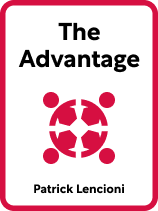

This article is an excerpt from the Shortform book guide to "The Advantage" by Patrick Lencioni. Shortform has the world's best summaries and analyses of books you should be reading.
Like this article? Sign up for a free trial here.
What is a healthy work culture? Why is a safe environment important for employees?
A safe working environment doesn’t just mean preventing injuries, it means creating a psychologically healthy place to work in for employees. According to Patrick Lencioni in his book The Advantage, a healthy work culture is crucial for building an effective team.
Keep reading to learn how to build a healthy work culture for your business.
Building a Safe Environment
Lencioni explains that building a healthy work culture in which members trust and understand each other is the foundation of a unified and effective team. Safety allows members to admit shortcomings, hold others accountable, have disagreements, ask for help, and share praise.
(Shortform note: While Lencioni mentions accountability as one benefit of a safe environment, the authors of Crucial Accountability emphasize accountability as the most important of the benefits Lencioni discusses. They elaborate that effective accountability conversations are the true cornerstone of a productive work environment because they facilitate the resolution of organizational problems and conflicts. To create a safe environment that promotes accountability, the authors explain that you must establish mutual respect and a shared purpose.)
To build a healthy work culture, Lencioni recommends holding an off-site meeting where members:
1) Share personal stories explaining the major parts of their life thus far—where they were born, what their family dynamic was, their personal interests, and the hardships and accomplishments they’ve faced in their life. This will give members a better understanding of each other’s behavioral tendencies and values. For example, you might realize that one member is sensitive to conflict because they grew up in a dysfunctional household.
(Shortform note: Getting to know team members by learning their backgrounds is arguably necessary because it contributes to what Charles Duhigg calls “social sensitivity,” a necessary ingredient for safety. In Smarter Faster Better, Duhigg explains that social sensitivity is the ability to read others’ emotions through their tone or body language. This allows team members to understand when others are upset, predict what might elicit an emotional reaction from them, and sense when they may need extra attention to feel valued and respected. Getting to know your team members will make it easier to read their tone and emotions, thus increasing your social sensitivity.)
2) Take a personality test, like the Myers-Briggs Type Indicator, and share their results with the team. This will give members insight into their peers’ likes, dislikes, communication styles, and so on, and will improve collaboration.
(Shortform note: While Lencioni recommends using a personality test like the Myers-Briggs Type Indicator (MBTI) to get to know your colleagues, this test lacks scientific standing and is widely criticized for various reasons. First, the MBTI was developed based on Carl Jung’s non-scientific personal insights—and recent research suggests that these insights were incorrect. Further, many people report receiving different results each time they take the test despite their lives remaining fairly consistent, which brings into question the test’s accuracy.)
3) Learn about the fundamental attribution error—a human trait that makes us more likely to unfairly judge others. The fundamental attribution error states that people tend to blame others’ negative behaviors on personal factors like their desires or traits, whereas we blame our own bad behavior on external factors (thereby absolving ourselves of responsibility). For example, you’re likely to blame a colleague’s outburst on their bad attitude but blame your own outburst on a stressful situation. However, if members understand each other (the purpose of the previous two activities in this list), they’ll be less likely to engage in the fundamental attribution error and level personalized blame, thereby creating a safer environment.
(Shortform note: In Crucial Accountability, the authors explain that making the fundamental attribution error during accountability conversations can spell disaster for professional relationships, and as Lencioni explains, diminish safety. However, rather than simply building mutual understanding between members and hoping it prevents the error as Lencioni suggests, the authors of Crucial Accountability recommend a specific strategy for avoiding it: Before forming opinions about someone’s actions or intentions, consider all of the personal, social, or environmental factors that might have influenced their behavior.)

———End of Preview———
Like what you just read? Read the rest of the world's best book summary and analysis of Patrick Lencioni's "The Advantage" at Shortform.
Here's what you'll find in our full The Advantage summary:
- How the biggest business advantage you can gain is free and within your reach
- How to create an effective leadership team
- How to maintain organizational health with effective meetings






